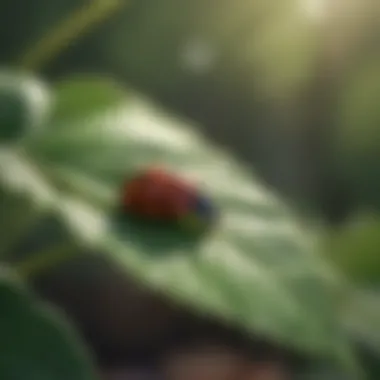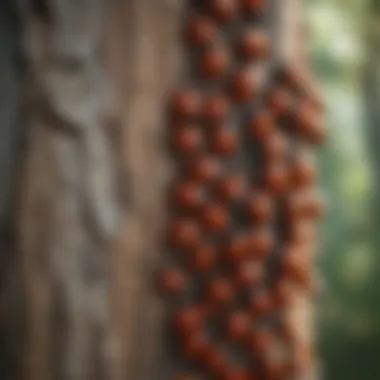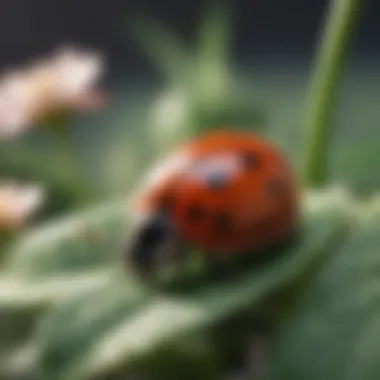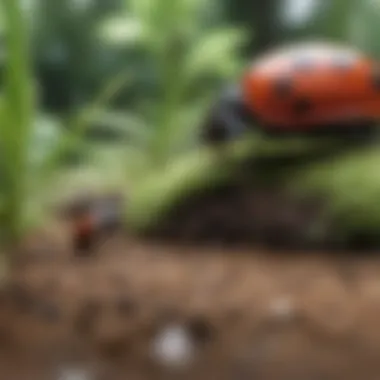Discovering Ladybug Habitats: Where to Find Them


Nature Topic Overview
Ladybugs, often referred to as ladybird beetles, are fascinating insects known for their striking appearance and beneficial presence in gardens and fields. This section will introduce the various habitats where ladybugs can be found, as well as shed light on their behaviors and preferences. Understanding these factors can enhance your chances of spotting them in the wild. Whether you are an avid nature lover, a teacher, or a parent guiding young explorers, this exploration aims to deepen appreciation for ladybugs and the ecological role they play.
Ladybugs thrive in diverse environments, ranging from gardens to forests. They are most commonly spotted on plants, where they feed on aphids and other pests. Their vibrant colors, such as red or orange with black spots, make them easily recognizable. These characteristics help them stand out in their habitats while also serving as a warning to predators about their potential toxicity.
Fun Facts and Trivia
Learning about ladybugs can be both enjoyable and educational. Here are some interesting facts to engage young readers:
- Lifespan: Ladybugs can live up to one year.
- Diet: A single ladybug can eat thousands of aphids in its lifetime.
- Types: There are over 5,000 species of ladybugs worldwide!
Incorporating visuals such as images or videos of ladybugs in action can help create a more engaging experience for children. Furthermore, quizzes can encourage kids to recall what they learned about these beneficial insects.
Wildlife Explorations
When exploring the world of ladybugs, it's essential to consider the various species that exist in different regions. For example, the Asian lady beetle and the thirteen-spotted ladybug are just two species you might encounter. Each species has its unique habitat preferences and behaviors.
"Ladybugs are a gardener's best friend! Their appetite for aphids can protect valuable plants from damage."
The habitats that attract ladybugs typically involve plants that provide food, shelter, and moisture. These habitats can include:
- Home gardens
- Agricultural fields
- Meadows
- Wooded areas
Including interactive elements, such as puzzles or matching games related to species identification, can make learning about these insects more fun for children.
Environmental Awareness
Understanding the importance of conservation is crucial for young minds. Ladybugs play a vital role in controlling pest populations naturally, reducing the need for chemical pesticides. Teaching children about sustainability and the positive impact of insects on the ecosystem can foster a sense of responsibility toward nature.
Simple actions like planting native flowers and avoiding pesticides contribute to healthy habitats for ladybugs and other beneficial insects. Here are a few tips for children who want to help protect nature:
- Create a ladybug garden by planting various flowers.
- Avoid using chemicals in the garden that may harm insects.
- Learn to identify local ladybug species and keep track of them during outdoor explorations.
DIY Nature Activities
Hands-on activities can further enrich a child's understanding of ladybugs and nature. Here are some fun projects:
- Ladybug Journal: Encourage children to keep a journal documenting their ladybug sightings. They can sketch pictures or write down their experiences.
- Crafts: Make ladybug crafts using rocks or paper plates. Children can paint or decorate them as they wish.
- Outdoor Exploration: Go on a nature walk to search for ladybugs. Provide children with magnifying glasses to observe them closely.
By combining learning with creativity, kids can develop a deeper connection to the environment, instilling a lasting appreciation for ladybugs and their habitats.
Understanding Lady Bugs
Ladybugs, often seen as charming garden inhabitants, play a vital role in our ecosystems. Understanding their behavior, diet, and habitats is essential to appreciate their significance in nature. In this section, we will explore what ladybugs are, why they are beneficial, and some common types found in different regions.
Defining Ladybugs
Ladybugs, also called ladybird beetles, belong to the family Coccinellidae. They have rounded bodies and often exhibit bright colors, such as red or yellow with black spots. These insects are not only pleasing to the eye but are crucial in controlling pest populations in gardens and farms. The larvae of ladybugs consume aphids, which are harmful to crops, making them a favorable ally for gardeners. Understanding their physical characteristics helps in identifying them in various settings.
Common Species
There are many types of ladybugs across the world. Here are a few common species you might encounter:
- Harmonia axyridis: Known as the Asian lady beetle, it is prevalent in North America. Its colors can vary from orange to black, making it versatile in appearance.
- Coccinella septempunctata: This is the seven-spotted ladybug, easily recognizable by its seven black spots on a red background. It is one of the most familiar species in Europe.
- Adalia bipunctata: Known as the two-spotted ladybug, this species is mainly black with red spots. It can help control aphid populations effectively.
Ladybugs are not only beautiful; they also serve as natural pest control agents, helping maintain balance in the ecosystem.
Natural Habitats of Lady Bugs
Understanding the natural habitats of ladybugs is crucial for anyone interested in observing these insects. Ladybugs thrive in various environments. Their presence indicates a healthy ecosystem. Knowing where to find them helps in appreciating their role in nature. This section will explore different habitats where ladybugs can be located, highlighting their preferences and the importance of these settings.
Garden Environments
Gardens are one of the best places to find ladybugs. These areas often provide the food sources that ladybugs need. Aphids are a primary food for ladybugs, and gardens frequently have plants that attract these pests.
To increase the chance of seeing ladybugs, gardeners can plant species like
- Marigolds
- Dill
- Fennel
These plants do not just attract aphids but also encourage ladybugs. Keeping the garden free from chemical pesticides is important. Chemicals can harm ladybugs and other beneficial insects.
Woodlands and Forests
Woodlands and forests provide another habitat rich with ladybugs. The diverse flora and fauna create an environment where ladybugs can find food and shelter.


Here, ladybugs often hide in tree bark or beneath leaves. They enjoy areas where moisture is present. This dampness supports the aphid population, establishing a perfect food source. Observing ladybugs in these habitats requires patience.
Fields and Meadows
Fields and meadows are open spaces that ladybugs find appealing. These habitats offer a vast landscape for exploration. Bright wildflowers flourish in these areas, attracting aphids. As such, they'll naturally lure ladybugs.
In these settings, it’s helpful to look closely at the plants. Ladybugs often dwell in clusters, making them easier to find if you check among the foliage or underneath the petals. Watching for movement can reveal their presence.
Wetlands and Marshes
Wetlands and marshes may seem less obvious for ladybug habitats, but they can also be found here. These areas support specialized ecosystems where ladybugs thrive among various water-tolerant plants.
These environments often host many insects, including aphids. Ladybugs come to feed and breed in these wet areas. Understanding the connection between wetlands and ladybugs can encourage people to protect these critical ecosystems.
"Ladybugs are crucial for maintaining the balance in ecological systems. Protecting their natural habitats ensures their survival and benefits agricultural systems."
Overall, recognizing the importance of these habitats is essential for lovers of nature. By understanding where ladybugs live, we can appreciate their role in our ecosystems.
Seasonal Behavior Patterns
Understanding the seasonal behavior patterns of ladybugs is essential for anyone interested in locating and observing these fascinating insects. Each season influences their activities, habitat preferences, and survival strategies. By recognizing these patterns, nature enthusiasts can enhance their chances of finding ladybugs and appreciating their roles in the ecosystem. In this section, we will explore the activities of ladybugs throughout the spring, summer, and autumn months, as well as the traits that support their life cycle.
Spring: Active Exploration
As winter fades, ladybugs emerge from their dormant state, marking the arrival of spring as a vibrant period for these insects. During this season, they actively search for food and suitable mating partners. Temperatures rise, which signals ladybugs to leave their overwintering sites. They are often found in gardens where flowers start to bloom. The presence of aphids also attracts ladybugs, as these pests serve as a primary food source.
Key Activities in Spring:
- Foraging: Ladybugs hunt for aphids and other soft-bodied insects.
- Mating: This is the time when many ladybugs start to pair for reproduction.
As the weather gets warmer, gardens filled with flowering plants become hotspots for ladybug activity. Observers in backyards should pay attention to these areas. Potent nectar plants can help entices ladybugs. Understanding their behavior during this time enriches the observation experience.
Summer: Peak Population
The summer months signify a peak in ladybug populations. In gardens, forests, and fields, hundreds of these insects can often be found coexisting peacefully. The abundance of food sources, such as aphids, caterpillars, and pollen, supports their growth and reproduction.
During this time:
- Feeding Frenzy: Ladybugs eat large amounts of pests, which acts as a natural pest control method.
- Nesting: Females lay eggs on plants near aphid colonies to ensure a food supply for the hatchlings.
"Ladybugs can consume up to 50 aphids in a single day, contributing greatly to reducing pest numbers in gardens."
Summer is an ideal time for nature enthusiasts to observe ladybugs in action. Using magnifying glasses can add to the experience of studying their behaviors closely.
Autumn: Preparations for Winter
As temperatures drop in autumn, ladybugs begin their preparations for the winter months. This season serves as a transition in which ladybugs seek shelter to survive the cold.
Key behaviors during this period include:
- Migration: Many ladybugs migrate to warmer locations or specific sites for overwintering.
- Group Shelter: They come together in large groups as they search for shelter; this behavior also helps maintain warmth.
Some ladybug species may enter buildings or find refuge under leaves, logs, or stones. Knowing this pattern can help observers locate them even when the weather cools.
In summary, the seasonal behavior patterns of ladybugs are multifaceted, influenced by climate and food availability. Recognizing these changes provides valuable insights into their ecology and increases the likelihood of successful observations.
Where to Locate Lady Bugs
Identifying the exact locations of ladybugs is crucial for those interested in studying or simply enjoying these beneficial insects. Knowing where to look can enhance the experience of observing them in their natural habitats. Ladybugs thrive in diverse environments, yet specific places yield better chances for sightings. This section explores three primary areas that can serve as habitats for these insects: your garden, indoor houseplants, and nature trails.
In Your Garden
Gardens offer an excellent opportunity to find ladybugs. A mix of plants, insects, and the right conditions can attract these creatures. Understanding plant choices and encouraging specific species can make your garden an inviting space for ladybugs.
Identifying Plant Species
Identifying plant species that attract ladybugs plays a significant role in creating habitats. Certain plants, like marigolds and nasturtiums, are known to lure ladybugs due to their nectar. These plants are appealing because they provide food and shelter.
Some key characteristics of these plants include:
- Bright Colors: Flowers that catch the eye of ladybugs.
- Nectar-Rich: Ideal for attracting adult ladybugs looking for food.
The advantage of incorporating these plants is that they not only attract ladybugs but also enhance the beauty of your garden. Although they may require some specific care compared to more common plants, the benefits of biodiversity yield a vibrant ecosystem.


Use of Beneficial Plants
Using beneficial plants can significantly enhance the presence of ladybugs in your garden. Certain flowers and herbs can serve both as nectar sources and habitats for ladybugs and other beneficial insects. Plants such as dill and fennel can provide refuge.
Their unique features include:
- Companion Planting: Beneficial plants often repel harmful pests, benefiting the garden.
- Seasonal Variety: Some plants bloom at different times, ensuring steady food availability.
While these plants may initially seem less common, their role in a balanced garden ecosystem is valuable. They create an environment where ladybugs can thrive, contributing to natural pest control.
Among Houseplants
Houseplants present another opportunity to find ladybugs, especially in well-tended homes. Since indoor conditions can vary, they are crucial for maintaining ladybug populations.
Checking Soil and Leaves
Checking soil and leaves in your houseplants allows for effective identification of ladybugs. These insects are often found on the undersides of leaves, where they feed on pests like aphids. Soil conditions can also affect their presence, as humidity and moisture play a critical role.
Key characteristics include:
- Moist Soil: Well-watered plants can create a more inviting atmosphere.
- Healthy Plants: Vigorous plants are less likely to attract pests, making it easier to spot ladybugs.
The advantage of monitoring these areas is to ensure a healthy environment for ladybugs and your plants. However, houseplants can also host other pests that are not beneficial, which requires careful observation.
Understanding Indoor Conditions
Understanding indoor conditions is vital when trying to attract ladybugs in homes. Factors such as temperature, light, and humidity can influence ladybug retention. Ladybugs prefer moderate temperatures and bright light, similar to their natural habitats.
Key characteristics include:
- Stable Environment: Avoid extreme temperature fluctuations.
- Natural Light: Bright but indirect sunlight can create conditions closer to the outdoors.
The unique aspect of mastering these conditions is fostering a suitable habitat for ladybugs. Indoor spaces that mimic the outdoors can lead to healthier populations, which might also improve control over indoor pests.
In Nature Trails
Nature trails often provide the best opportunities to observe ladybugs in their natural settings. Well-maintained trails with a variety of plants can host a large number of ladybugs and other beneficial insects.
Observation Techniques
Observation techniques are essential when exploring nature trails. Approaching with a gentle hand and eyes wide open can increase chances of spotting ladybugs. Look for loose bark, flower clusters, or patches of aphids on plants.
Key characteristics:
- Patience is Necessary: Observations can take time, so staying quiet helps.
- Use of Magnifying Glass: A simple tool can enhance your ability to spot small movements of ladybugs.
The advantage of adopting these techniques is the greater likelihood of successful identification in their habitats. However, be mindful about not disturbing the insects or their environment.
Timing Your Visits
Timing your visits is critical when exploring nature trails. Certain times of the day or year can yield better results. Ladybugs are most active during warm weather in the afternoon when temperatures are suitable for their activity.
Key characteristics include:
- Seasonal Changes: Spring through summer is ideal for sightings.
- Time of Day: Early mornings or late afternoons may be less successful.
Visiting at optimal times improves the chance of observing ladybugs. However, it can be affected by weather changes, so being flexible with plans is wise.
Overall, combining knowledge of these locations with careful observation techniques can significantly enhance your experience in locating ladybugs.
Factors Influencing Lady Bug Presence
Understanding the factors that influence the presence of ladybugs is crucial to appreciating their role in the ecosystem. These insects are beneficial for gardens and crops, as they help manage pests such as aphids. Knowing what attracts ladybugs can enhance your chances of observing them in nature. Three main elements affect their presence:
- Climate and Weather Conditions
- Availability of Food Sources
- Presence of Predators
Each of these factors can dictate whether ladybugs thrive in a particular area or not.
Climate and Weather Conditions
Climate plays a significant role in the distribution and activity of ladybugs. They prefer warm, temperate climates where they can thrive and reproduce. During warmer months, ladybugs are more active and easier to find.
- Temperature: Ladybugs are cold-blooded insects. They respond quickly to temperature changes. If it's too hot or too cold, they may become inactive. This is especially true in winter months when they hibernate in sheltered areas.
- Humidity: Adequate moisture is also essential. Ladybugs need a humid environment to maintain their physiological functions. Dry conditions can lead to dehydration.


In areas with less favorable climate conditions, you might find fewer ladybugs.
Availability of Food Sources
Food is another critical factor influencing ladybug presence. They primarily feed on aphids, but they also eat other small pests and some plant materials. The availability of these food sources can dictate where ladybugs settle.
- Aphids: The presence of aphids is a strong attraction for ladybugs. A garden with a significant aphid population will likely see an increase in ladybug activity.
- Flowering Plants: Ladybugs are drawn to flowering plants that attract aphids as well as nectar sources. Some favorite plants include marigolds, dandelions and cosmos. Creating a diverse garden with various flowering plants can enhance ladybug visitation.
When food is plentiful, ladybugs are more likely to inhabit that area.
Presence of Predators
The balance of the ecosystem is essential for ladybug survival. Predators can influence ladybug populations. The presence of birds and other insectivorous animals can decrease ladybug numbers.
- Natural Predators: Certain birds or insects may prey upon ladybugs, limiting their populations in some regions.
- Environmental Balance: A rich environment with various species helps maintain the balance. Fewer predators in an area can lead to an increase in ladybug numbers, improving their chances of being found.
Understanding these key elements helps cultivate an appreciation for these little creatures, vital in maintaining healthy ecosystems.
By paying attention to climate, food availability, and predator presence, observers can better anticipate where ladybugs might be found.
Engaging with Lady Bugs
Engaging with lady bugs is essential for fostering a better understanding of these insects and appreciating their role in the environment. Observation offers insights into their behaviors and habits. This knowledge allows people to promote healthy ecosystems. Encouraging curiosity about lady bugs inspires young nature enthusiasts to explore their surroundings.
When we engage with lady bugs, it also enhances our awareness of ecological balance. Observing this tiny creature can provide clues about the health of a garden or natural area. The more we learn and appreciate, the more we can contribute to their well-being.
Observation Guidelines
Approaching Without Disturbance
Approaching lady bugs without disturbance is vital for successful observation. This method prevents stress for the insects and allows them to behave naturally. Respecting their space leads to more accurate observations. If you suddenly move or make loud noises, the lady bugs may fly away. A gentle approach encourages them to stay in the area, making the experience more rewarding.
The key characteristic of this technique is mindfulness. Practicing mindfulness during observation is beneficial. It not only aids the observer but also protects the insects’ habitat. Observing without causing stress allows you to gather more meaningful data.
One unique feature is that lady bugs often cluster in groups. If you approach quietly, you may see various behaviors, such as feeding or resting. A disadvantage is that it may take patience. Sometimes, the best moments happen after waiting quietly.
Documenting Findings
Documenting findings is crucial for sharing your experience and knowledge. Keeping notes or drawing pictures allows for better retention of what you observe. It also contributes to a growing community of nature enthusiasts. This practice helps people who wish to track changes in lady bug populations or behaviors over time.
The key characteristic of documenting is accuracy. Accurate documentation is beneficial because it provides a clear record of what you have seen. This can help others learn from your experiences and even contribute to larger studies on lady bug habits.
A unique feature is the ability to identify species through documentation. When you record details, such as color patterns or behaviors, you can later match them to resources. However, it might require some effort to organize your observations effectively.
Conservation Importance
Role in Ecosystem
Understanding the role of lady bugs in the ecosystem is important. They serve as natural pest controllers, especially in gardens. Their diet consists primarily of aphids, which are known for damaging plants. By regulating these populations, lady bugs help maintain balance in the ecosystem.
The key characteristic of lady bugs is their significant impact on agriculture. They are a favorable option for gardeners looking to reduce pesticide use. This promotes healthier plants and leads to better insect biodiversity. As pest populations are controlled, plants can thrive more easily.
A unique feature is the ladybug's ability to reproduce quickly. When food sources are plentiful, ladybugs can significantly multiply over a short time. This rapid population growth can help quickly manage pest issues. However, the decline of lady bug populations would lead to a rise in pests, causing ecosystem imbalance.
Promoting Healthy Environments
Promoting healthy environments involves creating spaces where lady bugs can thrive. By planting certain flowers and avoiding pesticides, people can support the lady bug population. This simple act contributes greatly to the local ecosystem's health. Gardens that focus on biodiversity are often more resilient.
The key characteristic is habitat creation. It is a beneficial idea for both native insects and humans. Healthy environments support a variety of insects, contributing to pollination and improved plant health, which can be pleasing to the eye.
A unique feature of promoting health is its community aspect. Communities can work together to establish designated areas that support lady bug habitats. However, it requires a collective effort, and commitment from community members.
Engaging with lady bugs leads to a deeper understanding and appreciation for nature, highlighting the importance of each species in our environment.
Finale
The conclusion of this article plays a vital role in summarizing the key insights derived from our exploration of ladybugs. It condenses the various aspects of their habitats, behaviors, and the importance of observing these insects. Understanding where to find ladybugs helps cultivate a deeper interest among young readers and nature enthusiasts.
Summary of Key Points
- Understanding Ladybugs: We began by defining ladybugs and identifying common species, giving readers a foundation of knowledge about these insects.
- Natural Habitats: We explored environments like gardens, woodlands, and wetlands, where ladybugs thrive. Knowing their natural habitats is crucial for effective observation.
- Seasonal Behavior: Ladybugs exhibit different behaviors throughout the seasons. Recognizing these patterns helps in predicting their activity for better observation opportunities.
- Locating Ladybugs: Practical tips were provided on how to find ladybugs, from checking gardens to exploring nature trails, focusing on techniques that can enhance observing experiences.
- Factors Influencing Presence: Understanding climate, food sources, and predators gives further insights into why ladybugs may be present or absent in certain areas.
- Engaging with Ladybugs: By following guidelines on observation and conservation importance, readers are encouraged to connect with nature while also appreciating the role of ladybugs in our ecosystems.
Encouraging Continued Exploration
Encouraging young nature lovers to continue exploring the world of ladybugs can lead to a lifelong appreciation of biodiversity. It is important for children to engage with nature regularly. Here are some suggestions:
- Participate in Nature Walks: Take part in community nature walks or organize outings to local parks or gardens known for ladybug populations.
- Create a Ladybug Habitat: Involve children in setting up a small garden space dedicated to attracting ladybugs. Planting native flowers can magnetize these insects.
- Conduct Simple Experiments: Exploring temperature, moisture, and light conditions can be a fun way to see how these factors affect ladybug presence.
- Keep a Nature Journal: Encourage kids to document their findings, drawings, and observations about ladybugs they encounter. This improves their connection to nature and enhances their observation skills.
"Exploring the natural world ignites curiosity and fosters respect for all living beings."
By reinforcing these activities, future generations will become more aware of ecological relationships and the importance of every species, including ladybugs. The knowledge obtained throughout this article serves not only as a guide for finding these insects but also as a foundational step toward environmental stewardship.







